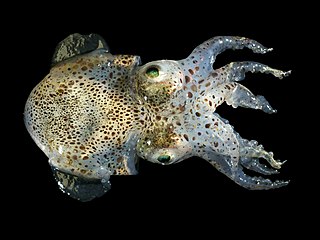
Sepiolidae is a family of bobtail squid encompassing 15 genera in three or four subfamilies. A gladius is absent in subfamily Heteroteuthidinae, and in subfamily Sepiolinae it is reduced, or absent like in genus Euprymna. A third subfamily is Rossiinae, and the genus Choneteuthis is considered to be Incertae sedis.

Stoloteuthis is a small genus of bobtail squid in the family Sepiolidae and the subfamily Heteroteuthidinae with one species, Stoloteuthis leucoptera, which is found in the western and eastern Atlantic Ocean, the Mediterranean Sea, the Indian Ocean, the Antarctic Ocean and the southwestern Pacific Ocean. The other species, Stoloteuthis japonica. was described in 2011 from a type specimen collected off northeastern Honshu.

Rossiinae is a subfamily of bobtail squid encompassing four genera and around twenty species.

Sepiolinae is a subfamily of bobtail squid encompassing 5 genera and more than 30 species.

Austrorossia is a genus of bobtail squid encompassing five species.

Semirossia is a genus of bobtail squid comprising three species.

Heteroteuthis is a genus of deep-sea bobtail squid comprising five species.

Iridoteuthis is a genus of bobtail squid comprising three species. They belong to the subfamily Heteroteuthinae of the family Sepiolidae.

Euprymna is a genus of bobtail squid comprising a number of species.

Sepiola is a genus of bobtail squid comprising around 15 species:
Heteroteuthis weberi is a species of bobtail squid native to the Indo-Pacific waters off central Indonesia.
Heteroteuthis dagamensis is a species of bobtail squid native to the southeastern Atlantic Ocean and southwestern Indian Ocean. It occurs off western, southern, and southeastern Africa.

Heteroteuthis hawaiiensis is a species of bobtail squid native to the central and western Pacific Ocean. It occurs in waters off Hawaii, Bonin, the Ryukyu Islands, Indonesia, and the Great Australian Bight. H. hawaiiensis may also be present in Banc Combe in the southwestern Pacific at depths of 795 to 820 m.

Sepiolina nipponensis, also known as the Japanese bobtail squid, is a bobtail squid and one of two species in the genus Sepiolina. It is found in the Western Pacific in apparently widely separated populations, the most southerly of which is in the Great Australian Bight in South Australia and Western Australia, and there are populations from the Philippines northwards to Taiwan, Fujian and southern Honshū.

Sepiolina is a small genus of bobtail squid in the family Sepiolidae and the subfamily Heteroteuthidinae from the western Pacific Ocean.
S. leucoptera may refer to:
Sepiolina petasus is a species of bobtail squid in the genus Sepiolina in the subfamily Heteroteuthidinae of the family Sepiolidae. It was originally collected in the Pacific Ocean near the Okinawa Islands. It was found to be sympatric with Sepiolina nipponensis but differs from that species by its relatively elongated posterior mantle, leading to more anteriorly situated fins.

Rossia is a genus of 10 species of benthic bobtail squid in the family Sepioidae found in all oceans. They live at depths greater than 50 m (164 ft) and can grow up to 9 cm in mantle length. This genus was first discovered in 1832 by Sir John Ross and his nephew James Clark Ross in the Arctic Seas, showing a resemblance to another genus under the same family, Sepiola. After returning from their expedition, Sir Richard Owen officially classified Rossia to be a new genus, naming it after Sir John and James Clark Ross.
Iridoteuthis merlini is a species of bobtail squid endemic to the open ocean off New Zealand as well as eastern and south-eastern Australia. I. merlini was discovered along with Iridoteuthis lophia by Dr Amanda Reid in 2021. Her findings were published in Zootaxa.












